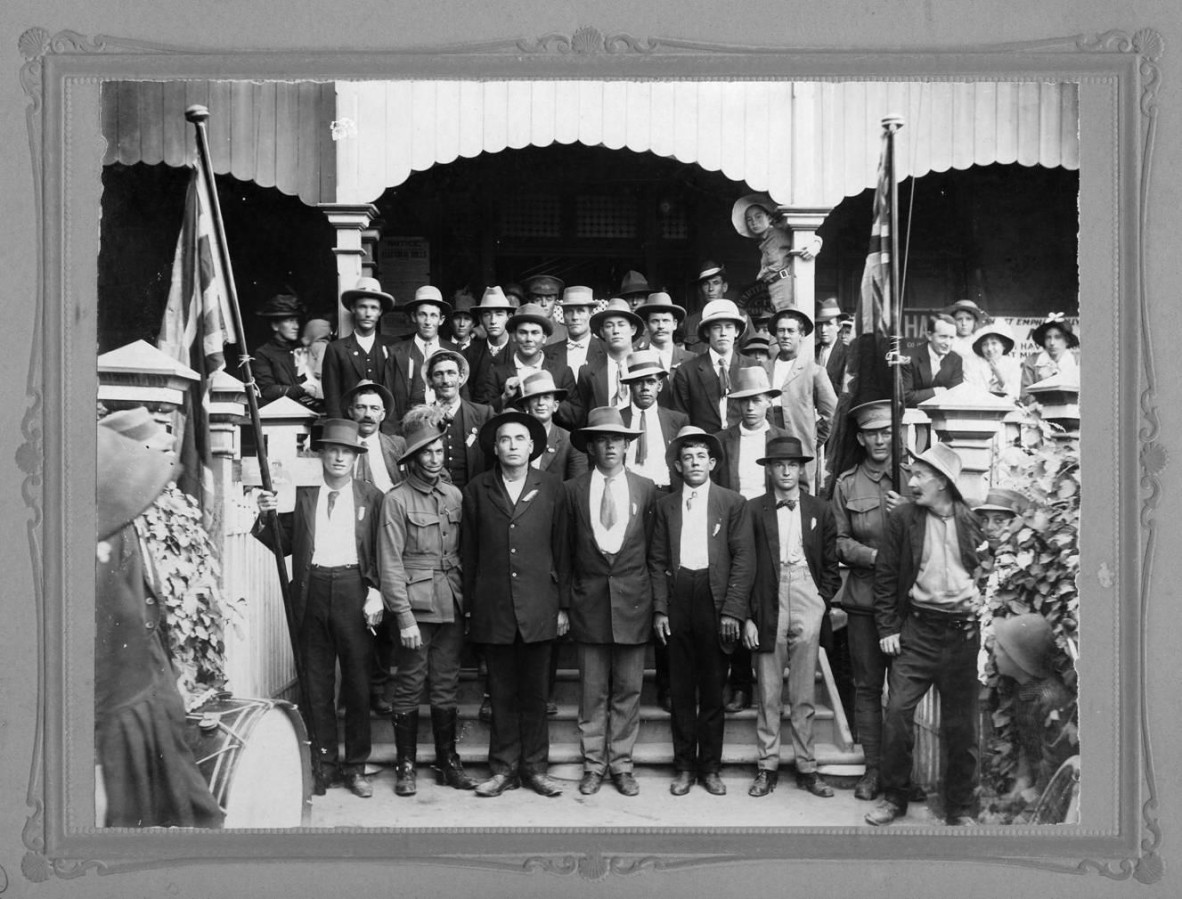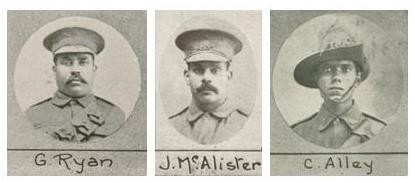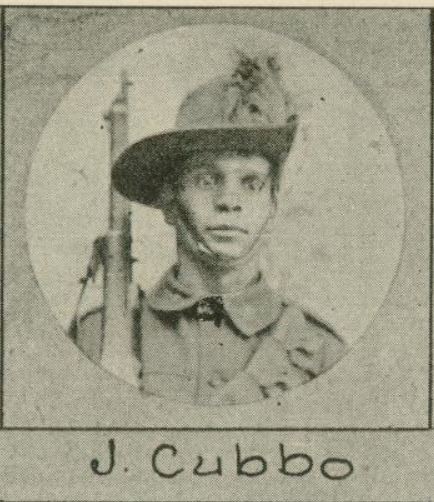Guest Blogger: Michael Brumby, Charters Towers Archives

First World War enlistees photographed outside the Charters Towers City Hall, Monday 26 June 1916 during an official send-off. Mainly from Pentland, among them was E. E. Cole, Frederick Peagham, Jack Towler, Alfred Janes, George Reid, F. S. Wharton, Richard Close, Francis Maloney, Tommy Ah Foo, Frederick J. Anderson, James Martyr, L. J. Brooks, Charles George, Frank Webb, Henry Harold Wilson, Rupert Ernest Wincen of Cloncurry and Felix Joseph Hamilton, who had been rejected in 1915 on medical grounds. Photo from Charters Towers Archives – Image 2015236.5127.
The two day Recruitment Conference held at the Dalrymple Shire Hall in Charters Towers in early January 1917 attracted local government delegates from all parts of the Kennedy Federal Electorate, as far west to Cloncurry, south to Winton and Georgetown in the north.
Sustaining enlistment numbers was foremost on the delegate’s minds given that 30,500 single and 30,000 married men throughout Queensland were still eligible for war service and hadn’t enlisted. Recruiting Sergeant Vincent was quoted in the Charters Towers newspaper saying “…part of the problem was authorities had been turning down half caste aborigines lately, but… one sent down the other day did not come back. There were a number of them available.” (1)
Indigenous enlistments arriving at Enoggera were received in one of two ways: some were refused entry while others were accepted.
The delegates, discussing the problem in Charters Towers agreed “…there were a number of eligible half-castes residing in the district who were anxious to go but met with a curt refusal. Mr Cramp moved a recommendation that these men be accepted...and be allowed to serve behind the lines at the very least”. Many who were accepted joined the Light Horse regiments.
Although Indigenous enlistment did not become official until 1917, it was reported in the newspaper on May 16, 1917 that Charters Towers Recruiting Officer William “Mack” Mackay had received official word from the Department of Defence stating:- “it has now been decided that half-castes may be enlisted in the A.I.F. provided that the examining medical officers are satisfied that one of the parents is of European origin”. (2)
This discrimination in Australia was first exposed at the outbreak of the war when in 1914 Herbert Nicholas presented himself in Sydney, only to be told Aboriginals were not being taken.
On 19 November, 1914 The Northern Miner (Charters Towers, Qld.: 1874 – 1954) reported that Nicholas "was grievously disappointed at the refusal".
Racial discrimination was less evident in north Queensland. Well-known police tracker Jingle passed his medical examination in Charters Towers in late August 1915 and made his way to Townsville for a final examination. The local newspaper quoted him as saying “ he was of the opinion that he would be of great service in night attacks,” but records held at the Queensland State Archives (Item ID317704) indicate he did not serve with the Australian Infantry Force (A.I.F.) (3)
Local boxer and athlete formerly of Cloncurry, Benjimin Bridgewater (SERN4444/ 4737) enlisted in September 1915.

Ben was intent on escaping a relationship and ongoing maintenance of his young son. In October (1915) he wrote to the mayor of Charters Towers, Alderman Fred Johnson, stating "...a soldier’s life is the life for me... it is a grand life. I am willing to give my life to pay for the time I am having here. No young fellow should miss the chance of having such a time. The officers here are very good. I got the handkerchief." (4)

Charters Towers was an enlistment centre commencing in 1915. Conducted under the auspices of the Charters Towers Municipal Council, the Chief enlistment officer was the Mayor. While most who enlisted were from ‘the Towers’, a sizeable number of enlistees came in from western towns and centres such as Winton, Hughenden, and Cloncurry.
In June 1916, George Reid (6508) enlisted with the men from Pentland, while Edward Smith (6524) from Homestead signed up a month later.
Those born in Charters Towers included George Ryan (B2455 4158 / 4159), Jack McAlister (7745), Jack John Brown (no details) and Charlie Alley (186382).

Approximately 100kms north west of Charters Towers, ‘Bluff Downs’ Station owner Mr. E.E.D. White agreed that several stock men in his employ could enlist - “…a record of which the station may feel justly proud”. They included: John Huggins (5689); Patrick Brady (50271); Bob Roberts (64377); Bobby Ewan (no details); Charlie Smith (64382)
Huggins, who was described “…as half-caste and a very fine stamp of a man about 30 years of age…” was not substantially white. It was reported “…he was anxious to proceed” at the end of 1914, but that Mayor Alderman Fred Johnson could not endorse him initially. The newspaper stated that Johnson did however write to headquarters, receiving communication that Huggins could proceed to Enoggera if he so desired.” (6) Huggins was accepted for service and in 1916, he served in Egypt and Europe.
John Cubbo (3121), who worked as a station-hand on John Clark’s ‘Mirtna Station’ to the south of Charters Towers had a similar experience.

He passed his first examination by Dr Fearnley and was signed off by recruiting Sergeant Mackay in August 1917. He was, however, recommended for discharge by the medical board at Enoggera based on the grounds he had insufficient European parentage. His father was aboriginal and his mother a half-caste.
He tried again a year later in June 1918. He was re-examined by the same doctor and endorsed by town clerk McClelland. He was 21 years of age on enlistment and served with the 5th Australian Light Horse Regiment. His wife, Eve Santo Cubbo awaited his return.
Others born in Charters Towers who enlisted elsewhere included William Christie (19606) who signed up at Barambah; Thomas Bowen (6522) in Narrabri, NSW; and Harry Doyle (2426) in Cairns.

Charles Tednee Blackman (2584A), one of three brothers who enlisted, born at Pine Tree Creek, via Gayndah was admitted to the Mosman Hall Special Hospital in Charters Towers under the name Charles Thomas Graham. The hospital opened in 1954. Charles died in the hospital in August 1966.
Michael Brumby, Community Historian
Charters Towers Archives Group
E: archives@charterstowers.qld.gov.au
Sources:
1. The Evening Telegraph (Charters Towers, Qld: 1901 – 1921) 17 Jan 1917, pg. 5
2. The Evening Telegraph (Charters Towers, Qld: 1901 – 1921) 16 May, 1917 pg. 2
3. The Northern Miner (Charters Towers, Qld.: 1874 – 1954) 30 August, 1915 pg. 4
4. The Northern Miner (Charters Towers, Qld.: 1874 – 1954) 26 October 1915 pg. 2
5. The Northern Miner (Charters Towers, Qld.: 1874 – 1954) 8 October, 1918, pg.3
6. The Evening Telegraph (Charters Towers, Qld: 1901 – 1921) 19 February 1915, pg. 2
Additional blog articles contributed by Michael Brumby, Charters Towers Archives
Comments
Your email address will not be published.
We welcome relevant, respectful comments.